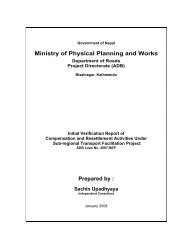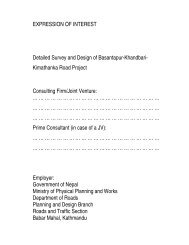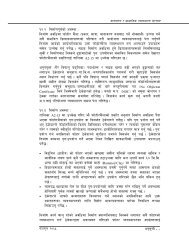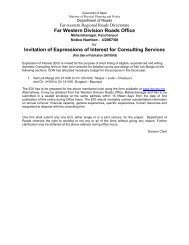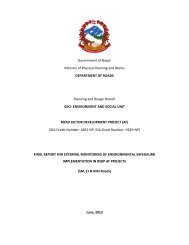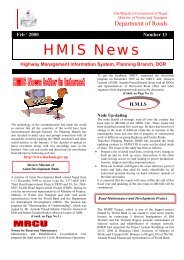Environmental & Social Management Framework - About ...
Environmental & Social Management Framework - About ...
Environmental & Social Management Framework - About ...
You also want an ePaper? Increase the reach of your titles
YUMPU automatically turns print PDFs into web optimized ePapers that Google loves.
<strong>Environmental</strong> and <strong>Social</strong> <strong>Management</strong> <strong>Framework</strong>indigenous people often have no recognized land ownership, and theyare not compensated for the land that is taken from them. Rather thanfight for their rights in an alien national legal system, they may withdrawfrom the new population centres, thus increasing the populationpressures on other, already traditionally occupied lands. In extremeinstances, physical conflict can break out between new settlers and theindigenous peoples, as the latter try to reclaim their heritage.- Address in the assistance programs specific health and social problems:The proposed assistance program needs to take into account that newarrivals of migrants, as well as the road construction crews, often bringwith them serious health and social problems to indigenous groups whonormally have weak defence mechanisms, for example againstintroduced disease, alcohol abuse, violence, sexual abuse, etc.c. Damages to Community Infrastructure and <strong>Social</strong> Life QualityExperience has shown that road construction activities often disrupt communityinfrastructures such as irrigation canals, drinking water supply systems, waterponds, schools and trails. Disruption is caused by siltation or burial of irrigationcanals, exposure and damages of water supply pipes. Such situation may lead toinconvenience to rural population in terms of carrying out their routine lifestyledue to disruption of facilities. Even worse, the effects of such impacts can haveserious consequences on public health and cause social conflicts. Equally, suchconflicts are likely to affect any smooth progress of works.• Preventive Measures:- Make adequate provisions and identify compensation arrangements inthe project’s planning documents, above all in the EMAP.- Include all identified precautionary measures in the works contracts andtailor the verification indicator in accordance to the respectivespecification clauses.- The project as well as the contractors should follow established rules andregulations for work safety and health, especially with respect to thoseactivities that bear on community life and resources (details see belownext point.• Mitigative Measures:- Explore the possibilities to engage a local experienced NGO to assist incommunity awareness program that depicts all aspects to facilitatesmooth progress of the work progress and addresses potential sources ofgrievances and social conflicts. The program shall also includeenvironmental awareness to promote the people’s conscience by actingas stewards for their natural environs.- CBOs, together with local health workers, shall control and regularlymonitor the quality and quantity of the water resources used by both thecommunity and the work forces. Incidents and observations of spills,pollutants or exceptional development of the groundwater table shouldbring to the immediate attention of the Resident Engineer who shall directthe Contractor for corrective measures, as applicable.- Both Contractor and representatives from the community and VDC shouldestablish an emergency (contingency) plan in case of major accidents (oilspill, fire) resulting from construction activities.- The Contractor shall inform the VDC and the community in due timeabout operations that may represent severance and nuisance, particularlyto announce traffic diversions, detour routes, river barrages and blasting.- Work activities causing air and noise emission in the neighbourhood ofsettlements should be avoided during night hours (8 p.m. to 5 a.m.).Chapter 6-18 April 2007



![j:6 ]zg cfof ]hgf](https://img.yumpu.com/51286794/1/190x245/j6-zg-cfof-hgf.jpg?quality=85)

![x'nfsL /fhdfu { cfof ]hgf](https://img.yumpu.com/50581959/1/190x245/xnfsl-fhdfu-cfof-hgf.jpg?quality=85)
